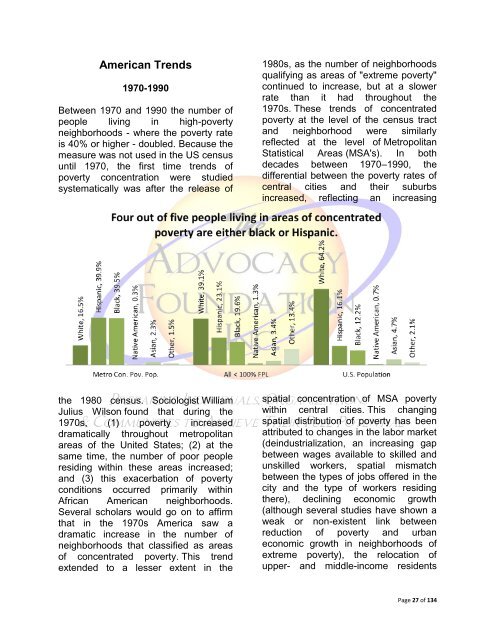Concentrated Poverty
Concentrated Poverty
Concentrated Poverty
Create successful ePaper yourself
Turn your PDF publications into a flip-book with our unique Google optimized e-Paper software.
American Trends<br />
1970-1990<br />
Between 1970 and 1990 the number of<br />
people living in high-poverty<br />
neighborhoods - where the poverty rate<br />
is 40% or higher - doubled. Because the<br />
measure was not used in the US census<br />
until 1970, the first time trends of<br />
poverty concentration were studied<br />
systematically was after the release of<br />
1980s, as the number of neighborhoods<br />
qualifying as areas of "extreme poverty"<br />
continued to increase, but at a slower<br />
rate than it had throughout the<br />
1970s. These trends of concentrated<br />
poverty at the level of the census tract<br />
and neighborhood were similarly<br />
reflected at the level of Metropolitan<br />
Statistical Areas (MSA's). In both<br />
decades between 1970–1990, the<br />
differential between the poverty rates of<br />
central cities and their suburbs<br />
increased, reflecting an increasing<br />
the 1980 census. Sociologist William<br />
Julius Wilson found that during the<br />
1970s, (1) poverty increased<br />
dramatically throughout metropolitan<br />
areas of the United States; (2) at the<br />
same time, the number of poor people<br />
residing within these areas increased;<br />
and (3) this exacerbation of poverty<br />
conditions occurred primarily within<br />
African American neighborhoods.<br />
Several scholars would go on to affirm<br />
that in the 1970s America saw a<br />
dramatic increase in the number of<br />
neighborhoods that classified as areas<br />
of concentrated poverty. This trend<br />
extended to a lesser extent in the<br />
spatial concentration of MSA poverty<br />
within central cities. This changing<br />
spatial distribution of poverty has been<br />
attributed to changes in the labor market<br />
(deindustrialization, an increasing gap<br />
between wages available to skilled and<br />
unskilled workers, spatial mismatch<br />
between the types of jobs offered in the<br />
city and the type of workers residing<br />
there), declining economic growth<br />
(although several studies have shown a<br />
weak or non-existent link between<br />
reduction of poverty and urban<br />
economic growth in neighborhoods of<br />
extreme poverty), the relocation of<br />
upper- and middle-income residents<br />
Page 27 of 134

















